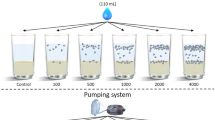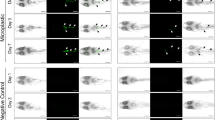Abstract
A growing number of studies have highlighted the contamination and the effects towards organisms of diverse microplastics (μPs) in the marine environment. Surprisingly, although the main sources of μPs for marine environments are inland surface waters, the information on the occurrence and the effects of μPs in freshwater ecosystems is still scant. Thus, the aim of the present work is to investigate the ingestion and possible adverse effects due to the exposure to polystyrene μPs (PSμPs; Ø = 3 μm) on tadpoles of the Amphibian Xenopus laevis. Larvae at the developmental stage 36, prior to mouth opening, were exposed under semi-static conditions to 0.125, 1.25, and 12.5 μg mL−1 of PSμPs, and allowed to develop until stage 46. At the end of the exposure, the digestive tract and the gills from exposed and control tadpoles were microscopically examined, as well as changes in body growth and swimming activity. PSμPs were observed in tadpoles’ digestive tract, but not in the gills, from each tested concentration. However, neither body growth nor swimming activity were affected by PSμPs exposure. Our results demonstrated that PSμPs can be ingested by tadpoles, but they did not alter X. laevis development and swimming behavior at least during early-life stages, also at high, unrealistic concentrations.





Similar content being viewed by others
References
American Society for Testing and Materials (ASTM) (1998) Standard guide for conducting the Frog Embryo Teratogenesis Assay-Xenopus (FETAX). p E1439–E1498
Barnes DKA, Galgani F, Thompson RC, Barlaz M (2009) Accumulation and fragmentation of plastic debris in global environments. Philos Trans R Soc B 364:1985–1998
Besseling E, Wang B, Lürling M, Koelmans AA (2014) Nanoplastic affects growth of S. obliquus and reproduction of D. magna. Environ Sci Technol 48:12336–12343
Chen Q, Gundlach M, Yang S, Jiang J, Velki M, Yin D, Hollert H (2017) Quantitative investigation of the mechanisms of microplastics and nanoplastics toward zebrafish larvae locomotor activity. Sci Total Environ 584:1022–1031
Cohen JT, Carlson G, Charnley G, Coggon D, Delzell E, Graham JD, Greim H, Krewski D, Medinsky M, Monson R (2002) Comprehensive evaluation of the potential health risks associated with occupational and environmental exposure to styrene. J Toxicol Environ Health B 5:1–263
Cole M, Lindeque P, Fileman E, Halsband C, Goodhead R, Moger J, Galloway TS (2013) Microplastic ingestion by zooplankton. Environ Sci Technol 47:6646–6655
Cole M, Lindeque P, Fileman E, Halsband C, Galloway TS (2015) The impact of polystyrene microplastics on feeding, function and fecundity in the marine copepod Calanus helgolandicus. Environ Sci Technol 49:1130–1137
Collard F, Gilbert B, Compère P, Eppe G, Das K, Jauniax T, Parmentier E (2017) Microplastics in livers of European anchovies (Engraulis encrasicolus, L.). Envrion Pollut 229:1000–1005
Desforges JW, Galbraith M, Dangerfield N, Ross PS (2014) Widespread distribution of microplastics in subsurface seawater in the NE Pacific Ocean. Mar Pollut Bull 15:94–99
Dris R, Imhof H, Sanchez W, Gasperi J, Galgani F, Tassin B, Laforsch C (2015) Beyond the ocean: contamination of freshwater ecosystems with (micro-)plastic particles. EnvironChem 12:539–550
Fendall LS, Sewell MA (2009) Contributing to marine pollution by washing your face: microplastics in facial cleanser. Mar Pollut Bull 58:1225–1228
Fossi MC, Panti C, Guerranti C, Coppola D, Giannetti M, Marsili L, Minutoli R (2012) Are baleen whales exposed to the threat of microplastic? A case study of the Mediterranean fin whale (Balaenoptera physalus). Mar Pollut Bull 64:2374–2379
Frydkjaer C, Iversen N, Roslev P (2017) Ingestion and egestion of microplastics by the Cladoceran Daphnia magna: effects of regular and irregular shaped plastic and Sorbed Phenanthrene. Bull Environ Contam Toxicol 99:655–661
Graham ER, Thompson JT (2009) Deposit- and suspension-feeding sea cucumbers (Echinodermata) ingest plastic fragments. J Exp Mar Biol Ecol 368:22–29
Gregory MR (1996) Plastic “scrubbers” in hand cleansers: a further (and minor) source for marine pollution identified. Mar Pollut Bull 32:867–871
Gulyás M, Bencsik N, Pusztai S, Liliom H, Schlett K (2016) Animal tracker: an ImageJ-based tracking API to create a customized behaviour analyser program. Neuroinformatics 14:479–481. https://doi.org/10.1007/s12021-016-9303-z
Hämer J, Gutow L, Köhler A, Saborowski R (2014) Fate of microplastics in the marine isopod Idotea emarginata. Environ Sci Technol 48:13451–13458
Hu L, Su L, Xue Y, Mu J, Xu J, Shi H (2016) Uptake, accumulation and elimination of polystyrene microspheres in tadpoles of Xenopus tropicalis. Chemosphere 164:611–617
Hu L, Chernick M, Hinton DE, Shi H (2018) Microplastics in small waterbodies and tadpoles from Yangtze River Delta, China. Environ Sci Technol 52:8885–8893
Imhof HK, Rusek J, Thiel M, Wolinska J, Laforsche C (2017) Do microplastic particles affect Daphnia magna at the morphological, life history and molecular level? PlosOne DOI 12:e0187590. https://doi.org/10.5061/dryad.9d84
Lavers JL, Bond AL, Hutton I (2014) Plastic ingestion by flesh-footed shearwaters (Puffinus carneipes): implications for fledgling body condition and the accumulation of plastic-derived chemicals. Environ Pollut 187:124–129
Lee K, Shim WJ, Kwon O, Kang J (2013) Size-dependent effects of micro polystyrene particles in the marine copepod Tigriopus japonicus. Environ Sci Technol 47:11278–11283
Lei L, Wu S, Lu S, Liu M, Song Y, Fu Z, Shi H, Raley-Susman KM, He D (2018) Microplastic particles cause intestinal damage and other adverse effects in zebrafish Danio rerio and nematode Caenorhabditis elegans. Sci Total Environ 619:1–8
Li WC, Tse HF, Fok L (2016) Plastic waste in the marine environment: a review of sources, occurrence and effects. Sci Total Environ 566:333–349
Lo HKA, Chan KYK (2018) Negative effects of microplastic exposure on growth and development of Crepidula onyx. Environ Pollut 233:588–595
Lusher A (2015) Microplastics in the marine environment: distribution, interactions and effects. Marine Anthropogenic Litter 245:307
Ma Y, Huang A, Cao S, Sun F, Wang L, Guo H, Ji R (2016) Effects of nanoplastics and microplastics on toxicity, bioaccumulation, and environmental fate of phenanthrene in fresh water. Environ Pollut 219:166–173
Messinetti S, Mercurio S, Parolini M, Sugni M, Pennati R (2018) Effects of polystyrene microplastics on early stages of two marine invertebrates with different feeding strategies. Environ Pollut 237:1080–1087
Murphy F, Quinn B (2018) The effects of microplastic on freshwater Hydra attenuate feeding, morphology & reproduction. Environ Pollut 234:487–494
Nieuwkoop PD, Faber J (1994) Normal table of Xenopus laevis (Daudin): a systematical and chronological survey of the development from the fertilized egg till the end of metamorphosis
Rist S, Baun A, Hartmann N (2017) Ingestion of micro- and nanoplastics in Daphnia magna—quantification of body burdens and assessment of feeding rates and reproduction. Environ Pollut 228:398–407
Scherer C, Brennholt N, Reifferscheid G, Wagner M (2017) Feeding type and development drive the ingestion of microplastics by freshwater invertebrates. Sci Rep 7:17006
Schindelin J, Arganda-Carreras I, Frise E (2012) Fiji: an open-source platform for biological-image analysis. Nat Methods 9:676–682
Stefatos A, Charalampakis M, Papatheodorou G, Fereninos G (1999) Marine debris on the seafloor of the Mediterranean Sea: examples from two enclosed gulfs in Western Greece. Mar Pollut Bull 38:389–393
Sussarellu R, Suquet M, Thomas Y, Lambert C, Fabioux C, Pernet MEJ, Le Goïc N, Quillien V, Mingant C, Epelboin Y, Corporeau C, Guyomarch J, Robbens J, Paul-Pont I, Soudant P, Huvet A (2015) Oyster reproduction is affected by exposure to polystyrene microplastics. Proc Natl Acad Sci U S A 113:2430–2435
Thompson RC, Olsen Y, Mitchell RP, Davis A, Rowland SJ, John AWG, McGonigle D, Russell AE (2004) Lost at sea: where is all the plastic? Science 304:838
Tosetto L, Broen C, Williamson J (2016) Microplastics on beaches: ingestion and behavioural consequences for beachhoppers. Mar Biol 163:199
Tussellino M, Ronca R, Formiggini F, De Marco N, Fusco S, Netti PA, Carotenuto R (2015) Polystyrene nanoparticles affect Xenopus laevis development. J Nanops 17:70
Watts AJR, Lewis C, Goodhead RM, Beckett SJ, Moger J, Tyler CR, Gallowat TS (2014) Uptake and retention of microplastics by the shore crab Carcinus maenas. Environ Sci Technol 48:8823–8830
Weber A, Scherer C, Brennholt N, Reifferscheid G, Wagner M (2018) PET microplastics do not negatively affect the survival, development, metabolism and feeding activity of the freshwater invertebrate Gammarus pulex. Environ Pollut 234:181–189
Wright SL, Thompson RC, Galloway TS (2013) The physical impacts of microplastics on marine organisms: a review. Environ Pollut 178:483–492
Xu XY, Lee WT, Chan AKY, Lo HS, Shin PKS, Cheung SG (2017) Microplastic ingestion reduces energy intake in the clam Atactodea striata. Mar Pollut Bull 124:798–802
Zbyszewski M, Corcoran PL, Hockin A (2014) Comparison of the distribution and degradation of plastic debris along shorelines of the Great Lakes, North America. J Great Lakes Res 40:288–299
Acknowledgments
We thank Dr. Marco Ortenzi and Dr. Stefano Antenucci for additional analyses of polystyrene μPs characterization.
Author information
Authors and Affiliations
Corresponding author
Additional information
Responsible editor: Philippe Garrigues
Electronic supplementary material
Rights and permissions
About this article
Cite this article
De Felice, B., Bacchetta, R., Santo, N. et al. Polystyrene microplastics did not affect body growth and swimming activity in Xenopus laevis tadpoles. Environ Sci Pollut Res 25, 34644–34651 (2018). https://doi.org/10.1007/s11356-018-3408-x
Received:
Accepted:
Published:
Issue Date:
DOI: https://doi.org/10.1007/s11356-018-3408-x




